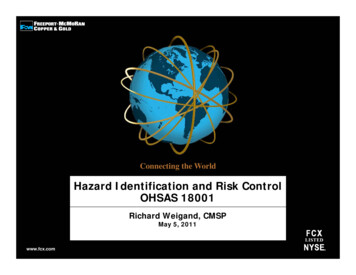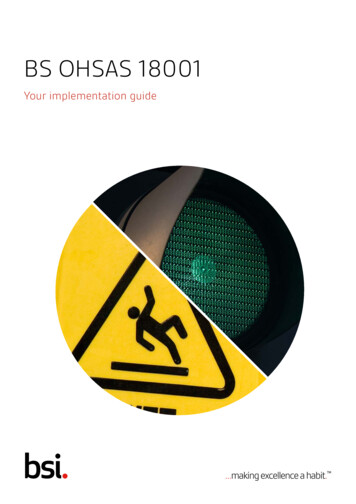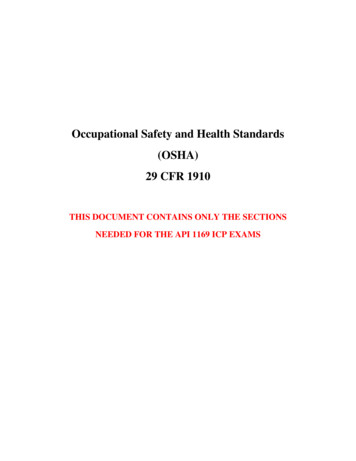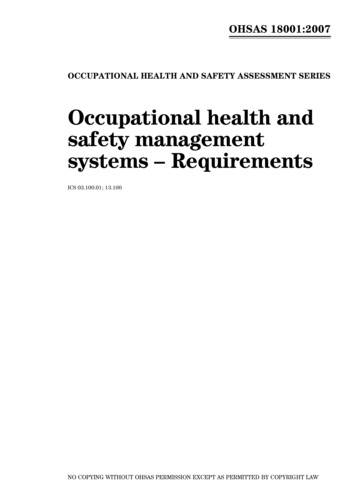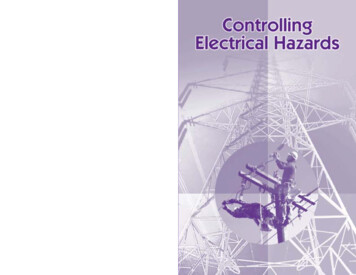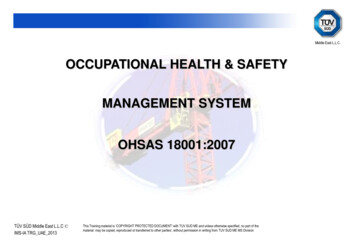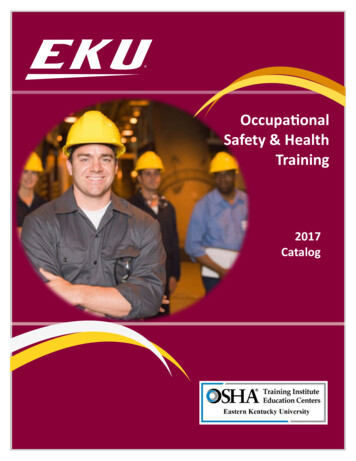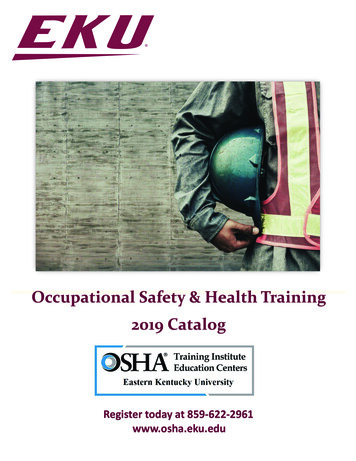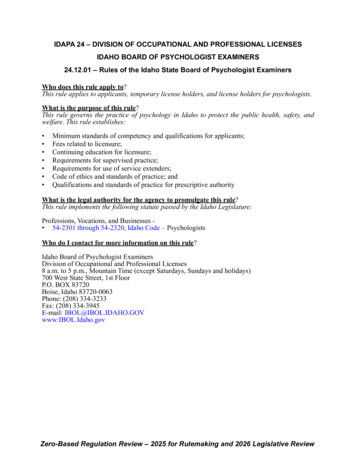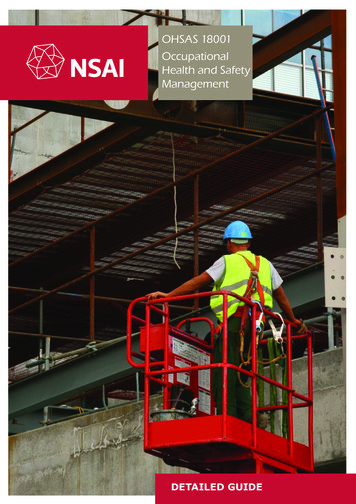
Transcription
OHSAS 18001OccupationalHealth and SafetyManagementDETAILED GUIDE
OHSAS 18001 BackgroundOHSAS 18001:2007 and accompanying OHSAS 18002, Guidelines for the implementation of OHSAS 18001,have been developed in response to customer demand for a recognizable occupational health and safetymanagement system standard against which their management system can be assessed and verified.OHSAS 18001 has been developed to be compatible with ISO 9001:2008 (Quality) and ISO 14001:2004(Environmental) management systems standards, in order to facilitate the integration of quality,environmental and occupational health and safety management systems by organisations, should they wishto do so.Organisations of all kinds are increasingly concerned with achieving and demonstrating sound occupationalhealth and safety (OH&S) performance by controlling their OH&S risks, consistent with their policy andobjectives. They do so in the context of increasingly stringent legislation, the development of policies andother measures that foster good OH&S practices.The advantages of an effective OHSAS managementsystem: Provides a structured approach formanaging OH&S Establishes and maintains a commitment tooccupational health and safety Demonstrates strong commitment to safetyexcellence Organisational structures in place with clearroles and responsibilities Existence of a continuous improvementculture Strong levels of trust and communication Reduction in incident levels with increasedmeasures of performance. Contributes to business performance byreducing cost and liabilities.Organizations which have attained registration through NSAI maintain that it leads to improved internaland external communications and a more disciplined attitude among employees to health and safetymatters through continuous improvement. OHSAS ensures a consistency of approach, which assurescompliance as a minimum.2MD-19-02 Rev 4
Fundamental Elements ofOHSAS 18001Occupational Health and Safety is based on: Hazard identification––The process of recognizing that a hazard exists (source or situation with the potential to cause harmin terms of human injury or ill-health) Risk assessment––The process of evaluating the risk arising from the hazard (combination of the likelihood of ahazardous event or exposure and the severity of injury or ill health that can be caused by the event ofexposure) Determination of applicable controls––Measures relevant to elminate or reduce risk to an acceptable level. Measures are based on thehierarchy of control measures.In order to achieve an effective health and safety system it is vital for organizations to handle these withgreater significance. The three aspects above provide the ever important foundation for implementingOHSAS 18001 and without them, the overall system would surely fail. They are, theoreticaly, considered apart of the ‘PLAN’ step (explained later), but most auditors and consultants agree that these aspects shouldbe dealt with before designing the system as a whole.OHSAS 18001 Occupational Health and Safety Standard uses a management approach tool called the PDCAcycle. PDCA is an ongoing process that enables an organisation to establish, implement and maintain itshealth and safety policy based on top management leadership and commitment to the safety managementsystem. It consists of the following:Plan – establish the objectives and processesnecessary to deliver results in accordance with theorganisation’s OH&S policyDo –implement the processCheck –monitor and measure performanceagainst OH&S policy, objectives, legal and otherrequirements, and report resultsAct – take actions to continually improve OH&SperformanceThe standard can be implemented to your whole organization or to just a part of it. The best results thoughcome when the whole organization is working on the same system and OH&S policy is integrated into othermanagement systems and into the culture of the organization.MD-19-02 Rev 43
Understanding the DetailPlanThe planning stage of the process requires theorganization to: Devise an OH&S policy Plan for hazard identification, risk assessment anddetermination of controls Identify relevant legal requirements Plan for emergencies and responses Manage change effectively Devise procedures for performance measuring,monitoring and improvement Provide and ensure the appropriate use of safetyequipment Train in order to introduce an OH&S cultureand establish the importance of organization’s safetystatement, policies and objectives Consult employees and communicateAt first, the management has to be consulted in order for them to feel confident in supporting the newsystem and constantly driving it forward. Then the workforce has to be consulted. It is very likely that thelower level employees have valuable insight, ideas and feedback about the new system. Since they are theones that are going to be most affected by it, it is logical to ensure they believe and understand the need forchange. Failure to realize this could result into much resistance throughout your organization and thus resultin a system that is impractical to operate.DoThe implementation stage should be the easiest part of this process. If the planning stage is done the rightway then it is just a matter of following the documentation and procedures that have been created. In orderto ensure smooth implementation a lead senior manager should be in charge of the new OH&S system andat the same time each element of the process should have an ‘owner’ or a person that looks after that partof the system. This ensures the appropriate structure at your organization and effectively minimizes risk.It is advisable to start the implementation by breaking the system down into specific elements rather thantackling it as a whole. Concentrating on specific elements in a logical order creates a solid foundation for thewhole system to work efficiently.Another important aspect of health and safety is having employees do the jobs that are suited to theircompetencies. A matrix should be created showing all groups of personnel, their required competencies,training and status of each. These formal procedures should instil the required awareness within yourorganization.4MD-19-02 Rev 4
Understanding the DetailCheckThe third step of the PDCA cycle consists of the following: Conducting internal audits Evaluation of legal compliance Identifying non-conformities and addressing them Thorough analysis of incidents and incidental data Measuring performance and monitoringThe failure to conduct internal audits periodically will most likely result in the breakdown of the system as awhole. It often happens that where there is no control, risks tend to arise especially quickly.Any arising non-conformities should be tackled instantly using the devised corrective actions. The mosteffective and robust systems ensure that this process runs smoothly at all times. This means that theperformance of this process should be measured as well and any non-conformities have to be dealt with.It is not only the arising non-conformities that your organization needs to think about. It’s crucial for yourorganization to identify any possible emergencies and develop relevant response procedures, this is calledpreventative action.When devising controls and measuring performance it is important to strike a balance between being overlybureaucratic and overly light on certain elements of the system. The OHSAS 18001 Occupational Healthand Safety Management Specification is not supposed to hinder the performance of your organization butimprove it.ActThe final step is the management review, it is a vital part of the continuous improvement process and so thestandard itself outlines what should be included in such a review.Management review is done by the seniormanagement and involves reviewing thesuitability, adequacy and effectiveness ofthe system. It should also include assessingopportunities for improvement and the necessityto change the OH&S policy and the OH&Sobjectives. If changes are needed, the seniormanagement should also provide the necessaryresources for their implementation. Providingresources is a way of presenting commitment tothe new health and safety system.MD-19-02 Rev 45
Key Steps To Getting Certifiedfor OHSAS 18001 by NSAI1.ApplyingYou can make certification application through our online quotations form or by phone, fax and email. Wewill review all the information and provide you with a company specific quotation. Our quotations covera three-year period corresponding to the certification cycle and are calculated to make sure that everycustomer receives the certification service best suited to their needs.2.Gap AssessmentApplicants can proceed at their own pace, with assessment dates arranged to suit. If you are unsurewhether you are ready to undergo assessment for registration, we can offer you a Gap Assessment, inwhich we: Conduct an on-site analysis of your current system Assess this against the relevant standard Prepare a report highlighting the gaps between your current system and the standard.A gap assessment is optional and is not a requirement of the certification process.3.Preliminary assessment – stage 1The Preliminary Assessment involves an inspection of your documentation and a review ranging overvarious areas including: The proposed scope of your registration The status of implementation of your management system The appropriate regulatory and legal requirements Your management policies and objectives Whether the system addresses the key areas of your business Your site-specific activities – top level process review Your key management elements, e.g. internal audits, reviews and complaints procedures Your readiness to move onto Stage 2 of the assessment, the Registration Assessment.The Preliminary Assessment normally takes place on-site. We recommend an interval of several weeksbetween the Preliminary Assessment and the Registration Assessment to allow time to resolve any issuesarising from the Preliminary Assessment.After the Preliminary Assessment is completed, we will produce a brief report evaluating your readiness toproceed to the next stage and identifying any areas that need to be improved before moving to Stage 2.If the Preliminary Assessment finds that your organization is not ready for full Registration Assessment, itbecomes, in effect, a Gap Assessment. That means that a second Preliminary Assessment will have to becarried out.6MD-19-02 Rev 4
Key Steps To Getting Certifiedfor OHSAS 18001 by NSAI4.Registration assessment – stage 2The Registration Assessment (Stage 2) involves a full review of your management system, including relevantrecords and documents. Its purpose is to confirm that your management system is properly controlled andhas predictable outcomes.At the end of the Registration Assessment, NSAI issues a detailed report, together with the outcome(whether to recommend registration or not). We will identify any issues found during the assessment. Youin turn will be expected to submit an action plan detailing what changes are planned to be made to themanagement system to eliminate or reduce the risk of the same issues re-occurring.5.Surveillance and re-assessmentAt least once a year, NSAI visits each registered company to ensure the management system is beingmaintained and is achieving its expected outcomes. During each visit, part of the management system isreviewed in depth.Certificates expire every three years, with the expiry date indicated on the certificate. Before that date, weundertake a detailed reassessment, reviewing the performance of the whole management system to makesure every element is performing satisfactorily. The results of the previous visits are taken into account.During the period of registration, changes are inevitable. NSAI works with each registered organization tomake sure the management system remains sound. Normally, change can be reviewed and assessed duringroutine surveillance visits. In cases where change leads to the breakdown of the system, NSAI reserves theright to suspend or revoke certification.For further information contact:NSAICertification Department1 Swift Square, Northwood,Santry, Dublin 9T. 01 8073800E. certification@nsai.ieW. www.nsai.ieMD-19-02 Rev 47
OHSAS 18001 has been developed to be compatible with ISO 9001:2008 (Quality) and ISO 14001:2004 (Environmental) management systems standards, in order to facilitate the integration of quality, environmental and occupational health and safety management systems by organisations, should they wish to do so. Organisations of all kinds are increasingly concerned with achieving and demonstrating .File Size: 1MBPage Count: 7
